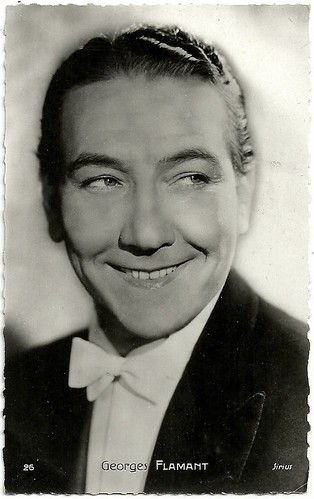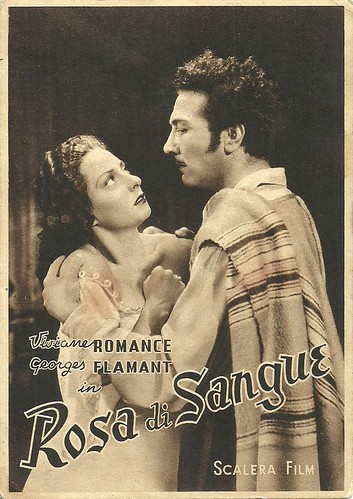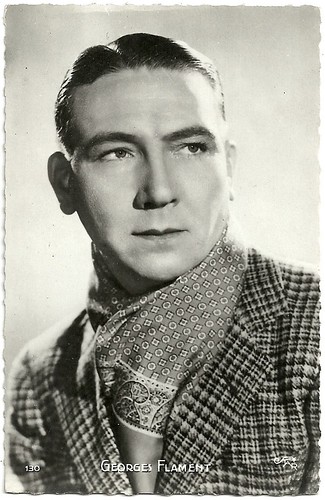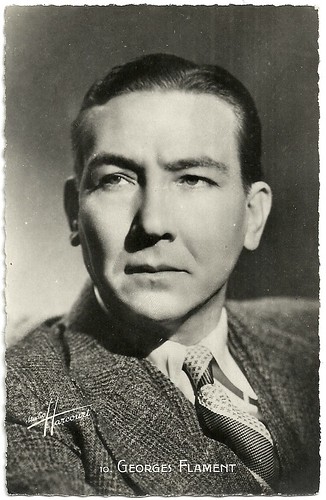French film actor Georges Flamant (1903-1990) started his career as a petty thief with an ignoble smile in Jean Renoir's La Chienne (1931) and the image of the bad guy and womaniser stuck. During the late 1930s and early 1940s, he peaked as the co-star of his beautiful wife, the film vamp Viviane Romance.

French postcard by Ed. Chantal, Rueil, no. 26. Photo: Sirius.

Italian postcard. Photo: Scalera. Viviane Romance and Georges Flamant in the Franco-Italian corpoduction Rosa di sangue/ Angélica (Jean Choux, 1940), based on the novel 'Les compagnons d'Ulysse' by Pierre Benoît.
Georges Flamant was born in 1903 in Tunis, while Tunisia was a French protectorate for over twenty years. As Pascal Donald writes at Ciné-Ressources, Flamant inherited the banter and the resourcefulness of the French in North Africa.
He stopped his studies early, practised several odd jobs and attended the world of petty crime. Arriving in Paris in the roaring twenties, he met the underworld of Montmartre and the Grands Boulevards where his seductive power was a hit with women.
When in 1931 Jean Renoir was preparing his first talkie, La chienne/The Bitch, he was looking for a convincing actor for Lulu’s (Janie Marèze) pimp Dédé, a small-sized, petty criminal with an ignoble smile. When the filmmaker met Georges Flamant, he knew he had found the man for his character. Dédé ends up unjustly convicted and executed after abusing the love of Lulu and the naivety of Mr. Legrand, played by Michel Simon, the real killer.
Subsequently, Georges Flamant was often type-cast in films as the bad guy. Still this enabled him to act together with popular actresses such as Käthe von Nagy in À moi le jour, à toi la nuit/The Day for Me and the Night for You (Ludwig Berger, Claude Heymann, 1932), Vera Korène in La voix sans visage/The Voice Without a Face (Leo Mittler, 1933), Suzanne Dehelly in La reine des resquilleuses/The Queen of Resquilleuses (Marco de Gastyne, 1934), and Gaby Morlay in La peur/The Fear (Victor Tourjansky, 1936).
In 1937 Flamant appeared with Raimu and Viviane Romance in L’étrange Monsieur Victor/Strange M. Victor (Jean Grémillon, 1937). He had already met Viviane in 1931 in Renoir’s La chienne, where she was an extra. They met again in Prison de femmes/Marked Girls (Roger Richebé, 1938) with Renée Saint-Cyr, and Le puritain/The Puritan (Jeff Musso, 1938) with Jean-Louis Barrault. Henceforth, Georges shared his life with the famous vamp of the French cinema.

French postcard by Editions P.I., Paris, no. 130. Photo: Star. NB. Flamant's name is misspelled as Flament.

French postcard by S.E.R.P., Paris, no. 10. Photo: Studio Harcourt.
During the following five years, Viviane Romance imposed her man in the headlines of seven productions with her: Gibraltar (Fédor Ozep, 1938) also with Erich von Stroheim, La tradition de minuit/The Midnight Tradition (Roger Richebé, 1939) also with Marcel Dalio, Angelica (Jean Choux, 1939) which was shot at the Roman Scalera studio and released in both a French and an Italian version, Vénus aveugle/Blind Venus (Abel Gance, 1940) also with Henri Guisol, Cartacalha (Léon Mathot, 1940) with Roger Duchesne, Une femme dans la nuit/A Woman in the Night (Edmond T. Gréville, 1941) with Claude Dauphin, and Feu sacré/Sacred Fire (Maurice Cloche, 1942) also with Franck Villard.
These films attracted huge audiences because of the sulfurous presence of Viviane, but Georges Flamant proved to be a rather poor actor, blatantly lacking charisma. After their separation in 1942, Georges's career suddenly stopped. Losing his credibility and without the protection of Viviane, no one hired him anymore. He lived on his notoriety in the company of pretty women and drowned himself in alcohol.
In 1948 Georges Flamant returned in a small role in an Italian film, Undici uomini e un pallone/11 Men and a Ball (Giorgio Simonelli, 1948)and he appeared in three French productions during the 1950s. In 1959, for his last film role, he played the rich and indulgent father of Patrick Auffray alias René, a friend of Antoine Doinel played by Jean-Pierre Léaud, in Les 400 coups/The 400 Blows, the first feature by François Truffaut.
As Pascal Donald writes, this was an unusual trajectory for a "part-time criminal" who wanted to be an actor, starting under the direction of Renoir and ending under that of Truffaut, and whose career was punctuated by a passionate and tumultuous relationship with one of the most beautiful movie stars.
After nearly two decades of neglect, Georges Flamant made a final appearance on television in the episode Maigret et Mr. Charles (Jean-Paul Sassy, 1977), with Jean Richard as commissaire Maigret. After this part, he returned to anonymity for good. Hospitalised in Villiers-le-Bel, Georges Flamant died in 1990, at the age of eighty-six.

French postcard by Massilia. Photo: Sam Lévin.

French postcard by Ed. Greff, Paris, no. 83. Photo: Studio Harcourt. NB Flamant's name is again misspelled as Flament.
Sources: CineArtistes.com (French), Wikipedia (French) and IMDb.
This post was last updated on 20 March 2024.

French postcard by Ed. Chantal, Rueil, no. 26. Photo: Sirius.

Italian postcard. Photo: Scalera. Viviane Romance and Georges Flamant in the Franco-Italian corpoduction Rosa di sangue/ Angélica (Jean Choux, 1940), based on the novel 'Les compagnons d'Ulysse' by Pierre Benoît.
Banter and resourcefulness
Georges Flamant was born in 1903 in Tunis, while Tunisia was a French protectorate for over twenty years. As Pascal Donald writes at Ciné-Ressources, Flamant inherited the banter and the resourcefulness of the French in North Africa.
He stopped his studies early, practised several odd jobs and attended the world of petty crime. Arriving in Paris in the roaring twenties, he met the underworld of Montmartre and the Grands Boulevards where his seductive power was a hit with women.
When in 1931 Jean Renoir was preparing his first talkie, La chienne/The Bitch, he was looking for a convincing actor for Lulu’s (Janie Marèze) pimp Dédé, a small-sized, petty criminal with an ignoble smile. When the filmmaker met Georges Flamant, he knew he had found the man for his character. Dédé ends up unjustly convicted and executed after abusing the love of Lulu and the naivety of Mr. Legrand, played by Michel Simon, the real killer.
Subsequently, Georges Flamant was often type-cast in films as the bad guy. Still this enabled him to act together with popular actresses such as Käthe von Nagy in À moi le jour, à toi la nuit/The Day for Me and the Night for You (Ludwig Berger, Claude Heymann, 1932), Vera Korène in La voix sans visage/The Voice Without a Face (Leo Mittler, 1933), Suzanne Dehelly in La reine des resquilleuses/The Queen of Resquilleuses (Marco de Gastyne, 1934), and Gaby Morlay in La peur/The Fear (Victor Tourjansky, 1936).
In 1937 Flamant appeared with Raimu and Viviane Romance in L’étrange Monsieur Victor/Strange M. Victor (Jean Grémillon, 1937). He had already met Viviane in 1931 in Renoir’s La chienne, where she was an extra. They met again in Prison de femmes/Marked Girls (Roger Richebé, 1938) with Renée Saint-Cyr, and Le puritain/The Puritan (Jeff Musso, 1938) with Jean-Louis Barrault. Henceforth, Georges shared his life with the famous vamp of the French cinema.

French postcard by Editions P.I., Paris, no. 130. Photo: Star. NB. Flamant's name is misspelled as Flament.

French postcard by S.E.R.P., Paris, no. 10. Photo: Studio Harcourt.
Blatantly lacking charisma
During the following five years, Viviane Romance imposed her man in the headlines of seven productions with her: Gibraltar (Fédor Ozep, 1938) also with Erich von Stroheim, La tradition de minuit/The Midnight Tradition (Roger Richebé, 1939) also with Marcel Dalio, Angelica (Jean Choux, 1939) which was shot at the Roman Scalera studio and released in both a French and an Italian version, Vénus aveugle/Blind Venus (Abel Gance, 1940) also with Henri Guisol, Cartacalha (Léon Mathot, 1940) with Roger Duchesne, Une femme dans la nuit/A Woman in the Night (Edmond T. Gréville, 1941) with Claude Dauphin, and Feu sacré/Sacred Fire (Maurice Cloche, 1942) also with Franck Villard.
These films attracted huge audiences because of the sulfurous presence of Viviane, but Georges Flamant proved to be a rather poor actor, blatantly lacking charisma. After their separation in 1942, Georges's career suddenly stopped. Losing his credibility and without the protection of Viviane, no one hired him anymore. He lived on his notoriety in the company of pretty women and drowned himself in alcohol.
In 1948 Georges Flamant returned in a small role in an Italian film, Undici uomini e un pallone/11 Men and a Ball (Giorgio Simonelli, 1948)and he appeared in three French productions during the 1950s. In 1959, for his last film role, he played the rich and indulgent father of Patrick Auffray alias René, a friend of Antoine Doinel played by Jean-Pierre Léaud, in Les 400 coups/The 400 Blows, the first feature by François Truffaut.
As Pascal Donald writes, this was an unusual trajectory for a "part-time criminal" who wanted to be an actor, starting under the direction of Renoir and ending under that of Truffaut, and whose career was punctuated by a passionate and tumultuous relationship with one of the most beautiful movie stars.
After nearly two decades of neglect, Georges Flamant made a final appearance on television in the episode Maigret et Mr. Charles (Jean-Paul Sassy, 1977), with Jean Richard as commissaire Maigret. After this part, he returned to anonymity for good. Hospitalised in Villiers-le-Bel, Georges Flamant died in 1990, at the age of eighty-six.

French postcard by Massilia. Photo: Sam Lévin.

French postcard by Ed. Greff, Paris, no. 83. Photo: Studio Harcourt. NB Flamant's name is again misspelled as Flament.
Sources: CineArtistes.com (French), Wikipedia (French) and IMDb.
This post was last updated on 20 March 2024.
No comments:
Post a Comment